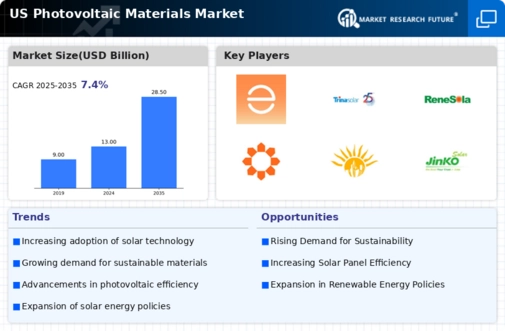The photovoltaic materials market is currently characterized by a dynamic competitive landscape, driven by technological advancements, regulatory support, and increasing demand for renewable energy solutions. Key players such as First Solar (US), SunPower Corporation (US), and Enphase Energy, Inc. (US) are strategically positioning themselves through innovation and partnerships. First Solar (US) focuses on developing advanced thin-film solar technology, which enhances efficiency and reduces costs, while SunPower Corporation (US) emphasizes high-efficiency solar panels and energy storage solutions. Enphase Energy, Inc. (US) is leveraging its expertise in microinverters and energy management systems to create integrated solutions that appeal to both residential and commercial markets. Collectively, these strategies foster a competitive environment that prioritizes technological differentiation and customer-centric solutions.
In terms of business tactics, companies are increasingly localizing manufacturing to mitigate supply chain disruptions and optimize logistics. This trend is particularly evident in the U.S. market, where firms are establishing production facilities closer to key markets. The competitive structure of the photovoltaic materials market appears moderately fragmented, with several players vying for market share. However, the influence of major companies is substantial, as they set industry standards and drive innovation through their investments in research and development.
In November 2025, First Solar (US) announced a partnership with a leading battery manufacturer to develop integrated solar-plus-storage solutions. This strategic move is likely to enhance First Solar's product offerings, allowing it to provide comprehensive energy solutions that meet the growing demand for energy resilience and sustainability. The collaboration may also position First Solar favorably against competitors who are still developing their energy storage capabilities.
In October 2025, SunPower Corporation (US) launched a new line of solar panels featuring enhanced efficiency ratings, which could potentially capture a larger share of the premium market segment. This innovation not only reinforces SunPower's commitment to sustainability but also addresses the increasing consumer demand for high-performance solar solutions. The introduction of these panels may further solidify SunPower's reputation as a leader in the high-efficiency solar market.
In September 2025, Enphase Energy, Inc. (US) expanded its product portfolio by introducing a new energy management platform that integrates solar generation, storage, and consumption data. This platform is designed to optimize energy usage for residential customers, potentially increasing customer satisfaction and loyalty. By enhancing its technological capabilities, Enphase Energy is likely to strengthen its competitive position in the rapidly evolving energy landscape.
As of December 2025, current competitive trends in the photovoltaic materials market are increasingly defined by digitalization, sustainability, and the integration of artificial intelligence (AI) into energy management systems. Strategic alliances among companies are shaping the landscape, enabling them to pool resources and expertise to accelerate innovation. Looking ahead, competitive differentiation is expected to evolve from traditional price-based competition to a focus on technological innovation, reliability of supply chains, and the ability to deliver comprehensive energy solutions. This shift underscores the importance of adaptability and forward-thinking strategies in maintaining a competitive edge in the market.























Leave a Comment